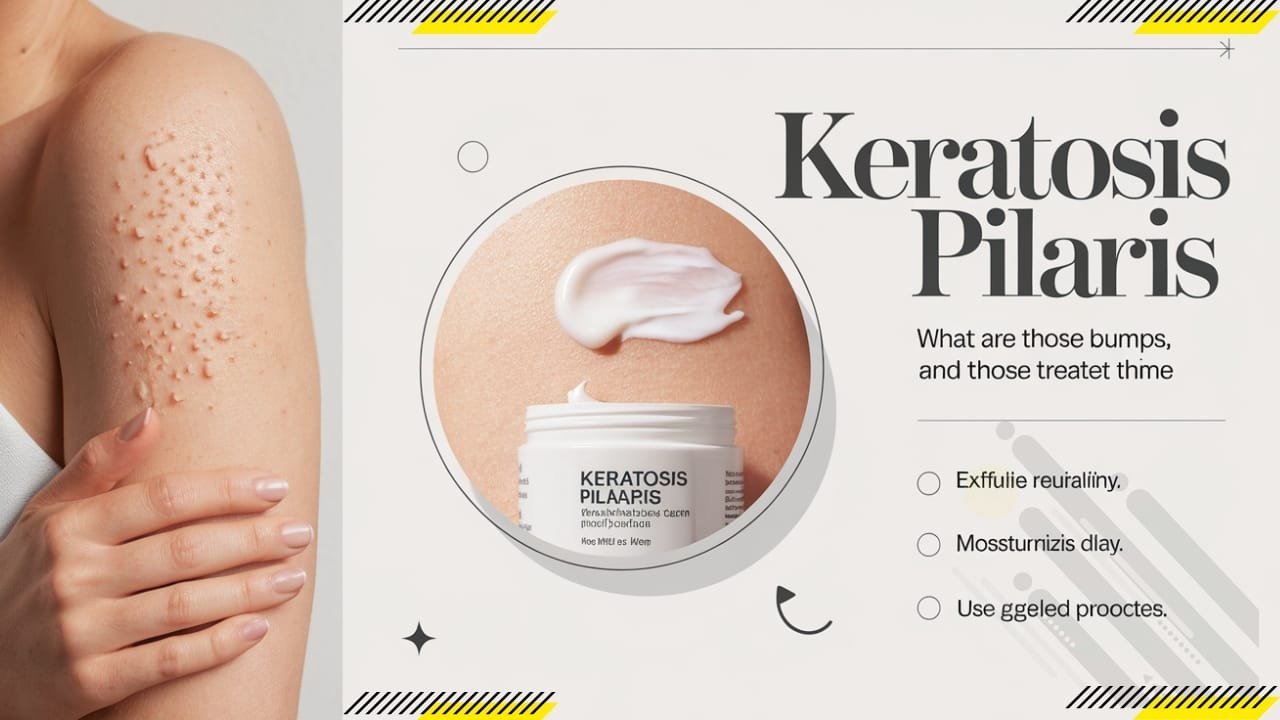Understanding and Managing Keratosis Pilaris (KP) Keratosis Pilaris (KP), often referred to as “chicken skin,” is a common, harmless skin condition c
Understanding and Managing Keratosis Pilaris (KP)
Keratosis Pilaris (KP), often referred to as “chicken skin,” is a common, harmless skin condition characterized by rough, bumpy patches on areas such as the arms, thighs, and cheeks. While it’s not a cause for medical concern, its appearance can be bothersome. This guide explains everything you need to know about KP, from its causes and symptoms to effective care tips and treatments.
What Is Keratosis Pilaris?
Definition
Keratosis Pilaris occurs due to the build-up of keratin, a natural protein that blocks hair follicles and forms rough, small bumps on the skin.
Most Commonly Affected Areas
- Upper arms
- Thighs
- Buttocks
- Cheeks
How Common Is Keratosis Pilaris?
- Prevalence: KP affects up to 40% of adults and 80% of teenagers, making it extremely common.
- Onset: Symptoms often start in childhood and become more noticeable during teenage years.
- Lifespan: Many experience reduced symptoms with age, while for some, KP remains lifelong.
Symptoms of Keratosis Pilaris
1. Rough, Sandpaper-Like Texture
KP creates uneven skin that feels rough to the touch, similar to sandpaper.
2. Small, Painless Bumps
- Bumps are tiny, painless, and may appear red or skin-toned.
- They are more noticeable when the skin is dry.
3. Specific Body Locations
- KP is typically localized to the arms, thighs, and buttocks.
- On the cheeks, it may resemble redness or rough patches.
Causes of Keratosis Pilaris
1. Keratin Build-Up
- Excess keratin clogs hair follicles, forming rough bumps.
- The reason behind keratin overproduction is not fully understood but appears linked to genetics.
2. Genetic Factors
- KP is often inherited.
- If your family has a history of KP, you’re more likely to develop it.
3. Dry Skin
- KP symptoms worsen during cold or dry weather.
- Dry skin amplifies roughness and bumpiness.
Who Is Most Likely to Get Keratosis Pilaris?
1. Age Group
- Children and teenagers are most affected.
- Symptoms may improve with age.
2. Family History
- A genetic predisposition makes KP more likely.
3. Skin Conditions
- Individuals with dry skin or conditions like eczema are more prone to KP.
Is Keratosis Pilaris Harmful?
- Harmless: KP is not a health risk and doesn’t require medical treatment.
- Cosmetic Concern: Its rough texture and visibility may cause self-consciousness, particularly in exposed areas like arms and cheeks.
Types of Keratosis Pilaris
1. Keratosis Pilaris Rubra
- Red, inflamed bumps.
- Commonly appears on the face, creating a flushed look.
2. Keratosis Pilaris Alba
- White or skin-colored bumps.
- Less irritation, with rough, patchy skin.
3. Keratosis Pilaris Rubra Faceii
- Specifically affects the cheeks.
- May resemble redness seen in rosacea but lacks visible blood vessels.
Differentiating Keratosis Pilaris from Other Skin Conditions
1. KP vs. Acne
- Acne involves pimples, blackheads, and whiteheads, often with pus.
- KP has smaller, painless bumps without pus.
2. KP vs. Eczema
- Eczema includes itching, redness, and fluid-filled blisters.
- KP doesn’t itch or inflame to the same extent.
3. KP vs. Rosacea
- Rosacea causes visible blood vessels and burning sensations.
- KP on cheeks lacks these features.
Daily Care Tips for Managing Keratosis Pilaris
1. Gentle Cleansing
- Use mild cleansers to maintain the skin’s natural moisture.
- Avoid harsh scrubbing, which can worsen symptoms.
2. Regular Moisturization
- Apply non-irritating lotions with ingredients like shea butter, glycerin, or urea.
- Moisturize daily to keep skin hydrated.
3. Avoiding Harsh Products
- Avoid soaps or exfoliants with strong fragrances or chemicals.
Lifestyle Adjustments for KP
1. Stay Hydrated
- Drinking water improves overall skin hydration.
2. Use a Humidifier
- Prevent skin dryness by adding moisture to the air during colder months.
3. Wear Soft, Breathable Fabrics
- Choose cotton and other non-irritating materials to reduce friction.
Natural Remedies for Keratosis Pilaris
1. Coconut Oil
- Helps lock in moisture and soften rough patches.
2. Oatmeal Baths
- Soothes dry, irritated skin.
- Add a cup of finely ground oatmeal to bathwater and soak for 10–15 minutes.
3. Aloe Vera Gel
Common Myths About Keratosis Pilaris
1. “KP Is Caused by Poor Hygiene”
- False. KP is a genetic condition unrelated to cleanliness.
2. “It’s Contagious”
- False. KP cannot spread from person to person.
3. “KP Can Be Cured Completely”
- False. There’s no permanent cure, but symptoms can be managed.
When to See a Dermatologist
Signs You Need Professional Help
- Persistent redness, irritation, or discomfort.
- Concerns about cosmetic appearance.
What to Expect During an Appointment
- Discussion of symptoms, family history, and skincare routine.
- Prescription treatments, like medicated creams, may be recommended.
Frequently Asked Questions (FAQs)
1. Can KP Be Prevented?
No, KP cannot be prevented due to its genetic nature. However, consistent skincare can reduce its appearance.
2. Does Diet Affect KP?
While no direct link exists, a balanced diet supports overall skin health.
3. Will Exfoliating Help?
Gentle exfoliation can improve texture but avoid over-exfoliating to prevent irritation.
4. Can KP Go Away Over Time?
For some, symptoms improve with age, though it may persist for others.
5. Is KP Linked to Other Health Issues?
No, KP is a benign condition and not associated with underlying health problems.
Conclusion
Keratosis Pilaris is a common and harmless condition that affects many people. While it cannot be cured, adopting a consistent skincare routine, making lifestyle adjustments, and exploring natural remedies can help manage its symptoms effectively. With the right care, you can enjoy smoother, healthier skin and minimize the impact of KP on your daily life.
